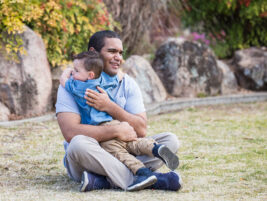Vignette
There are 9 people in the small living room, 2 families, 5 children.
Two of the adults are arguing; the five and six-year-olds are crashing toy cars; the TV is playing at full volume.
Luisa (pseudonym), 3, has one hand over her ears and is tugging on her mother’s leg.
“Mami, Mami, my corner! my corner!” she whimpers.
Her mother stops clearing plates from the table, “Que haces, mi hija?”
“My corner Mami!!!” begs Luisa.
Luisa’s mother, Flora (pseudonym), after a moment of confusion, remembers.
In a dyadic online video session, Flora, Luisa, and the therapist had created a “cozy corner” with a sheet over a coffee table. Luisa had snuggled in with a book and her favorite stuffed elephant. Absolutely no one was allowed in uninvited. Shortly thereafter, Flora somehow managed to arrange cozy corners for all 5 children.
Finding space for respite during quarantine in a small apartment is a necessity.
Introduction
Our program, Chances for Children – NY (CFC) is a therapeutic program serving families with children, birth to 5, in the South Bronx of New York City. The communities that CFC serves, have been among the hardest hit by the COVID-19 public health pandemic. One of the locations where we provide services is within an Early Head Start and home visiting program. They recently shared these devastating statistics: 70% of their families have been infected with COVID-19; entire families have been or are sick, including children. 100% of families lost their jobs. In all of our sites, families have been without essentials of daily life (food, diapers, formula) and are living in crowded circumstances that make staying at home particularly tense.
As COVID-19 lockdowns have changed New Yorker’s lives dramatically and altered routines in every area of functioning, CFC has also changed. As with most other therapeutic organizations, services now take place through a telehealth model using phone, video, and/or text depending on what a family can access. Alterations in both organizational and clinical structures were necessary.
The focus of this paper is to share questions, first thoughts, experiences, and vignettes from this complicated and often confusing transition from dyadic sessions in our offices to the telehealth screen. Though highly disguised case material is presented, it is meant to illustrate different elements of this transition, and not to be confused with caregiver-infant therapy case studies (for discussion of case material pre-COVID-19, please see Mayers & Siegler, 2004; Mayers, 2005).
Organizing the CFC telehealth model
During the first 2 weeks of the lockdown, CFC assessed the needs of clinicians and administration, secured access to encrypted video platforms, and to essential resources that families needed. Regular staff meetings considered both clinical and logistical conundrums while we created new necessary forms and ways to support staff self-care. Fortunately, because CFC is a small organization without layers of bureaucracy, we were able to make changes rapidly and effectively. These have allowed CFC to operate at full capacity through the pandemic.
Under usual conditions, CFC provides dyadic intervention, parent-infant groups, and a tier of intervention for babies and families who have undergone severely traumatic events. In our telehealth model, all families who had begun services before COVID-19 transitioned to telehealth. New referrals were offered telehealth consultation. For example, up to 5 hourly sessions specifically designed to reduce stress, to help establish and maintain daily routines during the pandemic, to provide guidance regarding children’s behaviors, and to offer strategies to support their development. Families needing further help became part of our dyadic intervention program. Parent- toddler groups continued, complete with songs, stories, and parent reflection, using an encrypted on-line platform.
Clinical considerations: the infant and family
Many questions challenged us as we considered managing the pandemic and this very new way of working. How can online screen intervention work with infants? What is needed on different levels to address the needs of parents, babies, other family members?
What is happening in the internal and external lives of different families: the pregnant woman, the new mother, the mother with multiple children now confined to home, the dyad who is suddenly reunited during the pandemic after being in foster care, the babies of separated parents who traveled between parents, parents, and babies now caught in multiple bureaucratic systems of child protection and the law?
The clinician
We know that good treatment requires that the therapist remain grounded, present, and steady, despite sessions with little ones that will be unpredictably state dependent, and contexts in which parents are getting sick and in some cases dying. Babies are being born, children are awaiting critical services, neighbors and friends are dying. In the transition to telehealth, many questions arose:
- What of the clinicians who are thrust from in-person, in-office contact to a remote platform with fewer options and many more potential difficulties?
- What does the therapist experience when the screen freezes and important communication is disrupted?
- How does the therapist’s frustration affect the client? How competent does the therapist feel with technology?
- How is the therapist’s response to her face on the screen, to her external environment, processed?
In short, clinicians are challenged to process new kinds of countertransference at each step of the way. Without readily available supervision and team processing, this would be a nearly impossible task.
The therapeutic alliance
Concerning the therapeutic alliance:
- What happens to the therapeutic alliance when dyadic sessions become meetings on a screen?
- How does the therapeutic encounter change?
- Perhaps the underlying question for all participants is “Will I be/am I safe here?”
According to neuroscientist Porges (2003), there is an adaptive mechanism in the brain that evaluates risk, moving a person toward defense or social communication. The concept that social communication cannot take place without a “felt state of security” makes the sense of safety a prerequisite to effective work (Geller & Porges, 2014).
- Can we create a virtual play space where parent and child can find what they need to understand and manage what is happening in their lives?
- Can the screen become a playground where the dyad can express, channel, and contain confusion?
With these question in mind, and in order to restore or to craft a therapeutic alliance, we must create a safe screen space where a parent can momentarily relax, where the child is freed from focusing on the welfare of caregivers, and where both caregiver and child feel safe enough to explore their own states of mind.
The move from in-person to video sessions: Juanita and Matthew
It is not surprising that the transition from in-person sessions to video was as unpredictable as everything else. Both Juanita (pseudonym) and Matthew (pseudonym) had had over 6 months of in-person sessions before the advent of COVID-19; Juanita for a terrifying trauma history, and Matthew for unmanageable behavior in preschool. Nevertheless, within their differences, these examples highlight children’s remarkable capacities to communicate their immediate concerns.
Juanita, 4, moved easily from in-person sessions to sessions on the screen, exclaiming
Hello Silvia! I am at home! You are in your house! Me too, I am in your house!
I will show you my bed! Silvia, are you washing your hands?
Here a long history of relational trust with her therapist allowed Juanita to communicate her most salient worry (her safety and the safety of those important to her) despite the strange novelty of the screen experience.
Matthew, nearly 3 1/2, on the other hand, was stony-faced when his therapist greeted him on the screen of his mother’s iPhone.
“Matthew,” the therapist remarked,
I see you are thinking. Maybe you are wondering why my face is on the screen. Everything is strange right now, isn’t it? We have to stay at home; mommy can’t take you to our play space. This is how we are going to see each other for a little while.
Matthew paused, thought, and went to his iPad.
The therapist wondered: Was he looking for the clinician on his iPad instead of his mother’s phone?
Was she there too?
As Matthew became more upset, it seemed nothing mom or the clinician said or did could help. He walked out yelling,
No! I don’t care!
The encounter lasted about 2 minutes.
Having put words to Matthew’s anger and letting him know that it was okay to be angry with her (and knowing that Matthew was safe in the kitchen with his grandparents) the clinician turned her attention to Matthew’s mother.
She understood the most useful intervention would be to lend her support to Matthew’s overwhelmed mother so that she, in turn, could better contain Matthew.
Matthew’s mother was an essential worker, struggling with daily frustration, anxiety, and fear. Because of childcare needs, both she and Matthew were confined to her very religious parents’ small home where her previously anxious parents were now further panicked by the virus. When not home, she was at work also surrounded by Coronavirus fear. As they spoke, Matthew crept into the room and hugged his mother before leaving once again, letting them know he knew his mother needed help too.
By the second session, Matthew was able to play constructively on the screen with the clinician for forty minutes, building a jail in which Batman was trapped. When the clinician reflected that maybe it feels like we are in jail too, that we want to go out and can’t, Matthew broke into the jail exclaiming, “Break it down! Batman is free!”
Indeed, at the beginning of the shutdown, many children played about breaking out of confined spaces or being squashed into overstuffed places. Matthew’s initial response to the confusion of the changed situation and the intense anxiety that surrounded him was his habitual stubborn, belligerent withdrawal. However, seeing that the clinician had not abandoned his mother or him, and would return reliably every week, he was able to return to productive play with them.
Initiating sessions with new clients
From its inception, the CFC program has tailored dyadic intervention to meet the needs of the individual family (Mayers, Hager-Budny, & Buckner, 2008). This has remained consistent in our work with adolescent parents, community parents, and now in our telehealth interventions. In some families, the COVID-19 pandemic has added new layers of chaos to prior turmoil. For others, it heightened already rigid coping styles.
For clinicians and families alike, the timing and flow of sessions on screen are more unpredictable than usual. Now they are impacted not only by the emotional states of the parent, child, and therapist, but by technology that freezes unexpectedly, creates lags between words spoken and words received, or crashes entirely if a child gets excited and bumps into a screen.
In addition, many families are living in cramped conditions that make finding a private space often impossible. Dialogue and play are often interrupted. Interactions that appear to be private can sometimes reveal any number of onlookers as people outside of the screen view begin to move around.
The disruption of our usual therapeutic frame, along with the security and scaffolding it provides, can leave clinicians feeling unmoored. We have learned the importance of adjusting expectations and not taking too personally when these adjustments may not work. The following two vignettes illustrate different interventions that depended on the need of the family.
Pedro
Our CFC clinician had not met Pedro (pseudonym) (aged 3 and a half) before the COVID-19 shutdown. He had been referred by his pediatrician who could not find any physical cause for Pedro’s refusal to use the toilet for bowel movements (although he urinated easily there). Pedro had told his parents he “didn’t know how” and was afraid, though he could not explain why. Typical labeling of feelings and behavioral strategies had not worked.
Before the first session, Pedro’s mother had set out various toys that Pedro liked and some playdoh that she was able to provide at the therapist’s request. Playdoh (especially the homemade very-soft kind) can have a deeply soothing effect on parent and child alike while also providing an outlet for aggressive play that can require full-body engagement and energy.
During this session, Pedro, his mother, and the clinician pushed, pulled, squeezed, smashed, and cut playdoh. After some time, Pedro began to build a house from magnetic blocks. When the clinician asked if there was anything in the house, Pedro replied a kitchen and a bed. She wondered if there was a bathroom in the house.
Yes! said Pedro surprised.
Help me build a potty Mommy; I will build the shower.
Pedro placed an action figure on the potty.
Now you build a house Mommy; I will make a tunnel…then we can go between without going outside, right?
Pretty soon playdoh was filling the houses, oozing through windows and doors, flooding the tunnel, and the potties, along with everything else. Action figures were buried, hidden, and found.
In the best of times, life is full of contradictions and confusions for little ones. Inside and outside can have multiple meanings—in my body/outside my body, in my house/outside my house, what can my house/body hold, what fits and what spills, what belongs there and what does not, who is in charge?
Clearly, Pedro had found enough safety in the presence of the therapist and on the playground of the screen to begin to communicate many different worries from fears of leaving the house safely to safely surviving his bowel movements. Here we had a beginning.
Scarlett
Scarlett (pseudonym) at 4 months had just returned to her birth mother, Letitia (pseudonym), from foster care. Letitia, twenty years old and a single mom, had tested positive for marijuana in the hospital. Child protective services had been called and Scarlett was placed in care. Just as Letitia completed the substance abuse program required for the return of her child, sheltering-in-place was mandated. Family courts shut down and processes ground to a halt. As systems struggled to organize, Letitia struggled to maintain contact with her newborn and to establish an identity as Scarlett’s mother.
Letitia and Scarlett were referred to CFC by child protective services after Scarlett’s return. Here was another program, mandated by a terrifying system that had “snatched her daughter from her,” intruding into Letitia’s newly created family, just as she was trying to figure out how to keep herself and her baby safe in a neighborhood overwhelmed by COVID-19.
The intervention began via phone as the therapist tried to understand the story of Scarlett and Letitia, from pregnancy through birth, separation, and reunion. In these calls, Letitia and her therapist built an alliance and enough trust for Letitia to let the therapist into her home via video.
For this first session, a solemn Scarlett was placed in a car seat facing the screen. A steady stream of high-pitched chatter served as background while a disembodied arm appeared on the screen offering Scarlett one toy after another, all of which the baby ignored. Struggling with a myriad of feelings, the therapist (TH), plunged in and began to talk with the baby and her mom.
TH: Hello Scarlett. I am Hillary. Your mommy has told me so much about you and I am so happy to see you. Mommy wants us to see all the lovely things you have.
Scarlett is alert to the screen. There is silence as the arm pushes a stuffed rabbit into Scarlett. Scarlett grimaces and turns away.
TH: You know Scarlett, I would really like to meet your mommy. Do you think you could introduce us?
L: (giggling) “Hi Hillary!”
TH: THERE you are Mommy. I hear you.
There is a long pause, and I am struck by how difficult it is to sit with silence on a screen.
TH: You know, Scarlett, you can see me, and I can see you, but you can’t see mommy and I can’t see her either!
Letitia begins to shake a rattle loudly off screen.
TH: We know she is there though, don’t we? We hear her. (Another long pause.)
TH: I wonder, Letitia, what do you think it is like for Scarlett to see the toys and hear your sounds and not see you?
L: She knows I am here. (Letitia turns the baby’s chair sideways so she and Scarlett can see each other while Letitia remains out of the picture.) See Scarlett here I am!
TH: Scarlett saw you, and then she didn’t see you, and now she sees you again, just like when she was in foster care. Now you are together.
At the end of this session, Letitia was able to allow the therapist to see her on the screen. They were able to play together with Scarlett, to reflect on the time it can take to get used to people, toys, and new situations, and this allowed Letitia to slow down her play to Scarlett’s pace.
Finally, they were able to reflect on Letitia’s need for Hillary to understand firsthand how terribly difficult it is not to be able to see someone important, and Letitia began to share her 4 months of grief.
As Letitia was listened to and heard, she became hopeful that the separation from Scarlett could be repaired and she could indeed become the mother Scarlett needs.
Can telehealth be effective?
Anecdotal findings: Qualitatively, anecdotally, it appears that telehealth can be effective. However, from a more quantitative perspective, it is difficult to know what to measure, how to define success, and what to use as a baseline?
At the simplest level, the absence or reduction of symptoms might be a useful measure. However, as the pandemic continues, new uncertainties surface as communities struggle to figure out how to resume a less sheltered existence. School re-openings bring added stress to families. These stresses are communicated to children and frequently result in renewed symptoms. This makes symptom reduction a less robust indicator of treatment effectiveness.
Usual CFC Assessment measures: Along with some standard assessment instruments, CFC uses pre/post-intervention video recordings of parent-child interactions (blind coded) to assess progress in the dyad. However, during the pandemic video recordings have not been possible given concerns over confidentiality in overcrowded homes and unreliable internet.
A CFC COVID-19 adapted measure to evaluate the effectiveness of telehealth
In an attempt to capture some measurable data, CFC designed three tools:
1. An Exit Survey anonymously completed by families when intervention is complete. This survey assesses a reduction in stress and satisfaction with services received.
2. A Pre-Intervention Questionnaire, given to the parent remotely, assesses a baseline of general stress and stress in the parent-child relationship.
3. A Clinical Session Rating Scale, rated by the clinician after each video session, to assess elements of behavior in the parent, child, and dyad.
As CFC has just begun using these measures, there are no results available yet.
Conclusion
With the ongoing impact of COVID-19 on our communities, our journey into infant-parent telehealth continues. We have learned many lessons, among them that dyadic work can endure, offering critical support to families that reduces isolation, encourages development, and nurtures hope. A great benefit of telehealth has been the scope of its reach, allowing us to reach families who without this option might never have had access to help. The challenges are many: the technology itself, the barrier of the screen which constrains what we see, smell, and touch, the remaking of the therapeutic frame, and of building new, safe alliances virtually. Here we benefitted greatly from the flexible structure of our model that could accommodate changes in delivery while maintaining critical core principles.
We have learned not to be surprised when schedules collapse and know there will be an on-going struggle with the challenge of regaining our own regulation and renewing a reflective stance as the circumstances around us continue to shift. We continue to be surprised that very little ones build relationships with us in just a few minutes on a screen and remember us the next hour. Perhaps most importantly, we are grateful that within the mess and confusion, the remarkable power of play to contain, work through, and resolve difficulties remains astonishing, inspiring, and healing for dyad and clinician alike.
References
Geller, S. & Porges, S.W. (2014). Therapeutic Presence: Neurophysiological Mechanisms Mediating Feeling Safe in Therapeutic Relationships. Journal of Psychotherapy Integration © 2014 American Psychological Association, 24(3), 178–192.
Mayers, H., Hager-Budny, M., & Buckner, E. (2008). Chances for Children teen parent-infant project: Results of a pilot intervention for teen mothers and their infants in inner-city high schools. Infant Mental Health Journal 29(4), 320-342.
Mayers, H. (2005). Treatment of a traumatized Adolescent mother and her two-year-old
son. Clinical Social Work Journal, 33(4), 413-425.
Mayers, H. & Siegler, A. (2004). Finding each other: Using a psychoanalytic developmental perspective to build understanding and strengthen attachment between teenaged mother and their babies. Journal of Infant, Child and Adolescent Psychotherapy, 3(4), 444-465.
Porges, S. W. (2003). Social engagement and attachment. Annals of the New York Academy of Sciences, 1008(1), 31-47.
Authors
Mayers, Hillary,
LCSW., Co-founder Chances for Children (CFC) Bronx, New York








